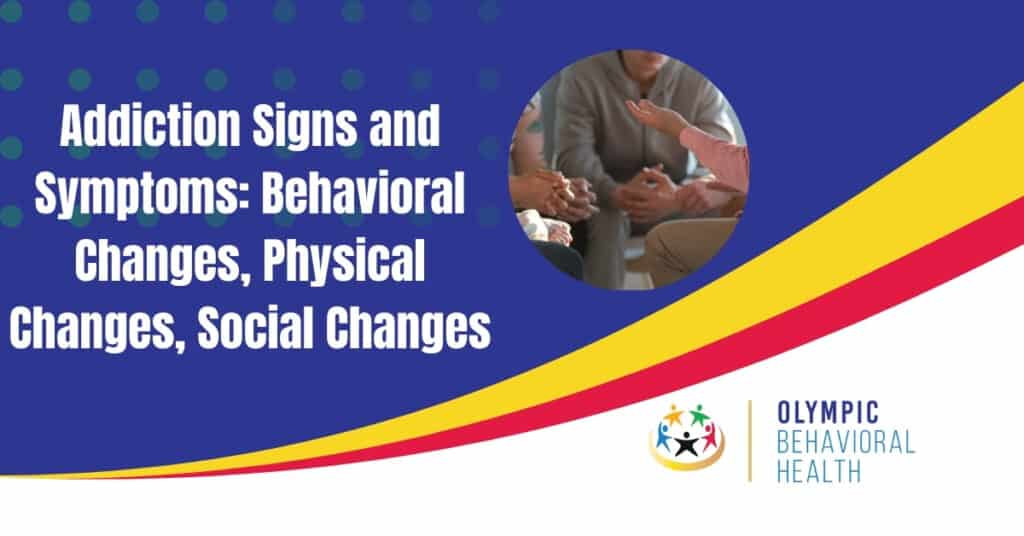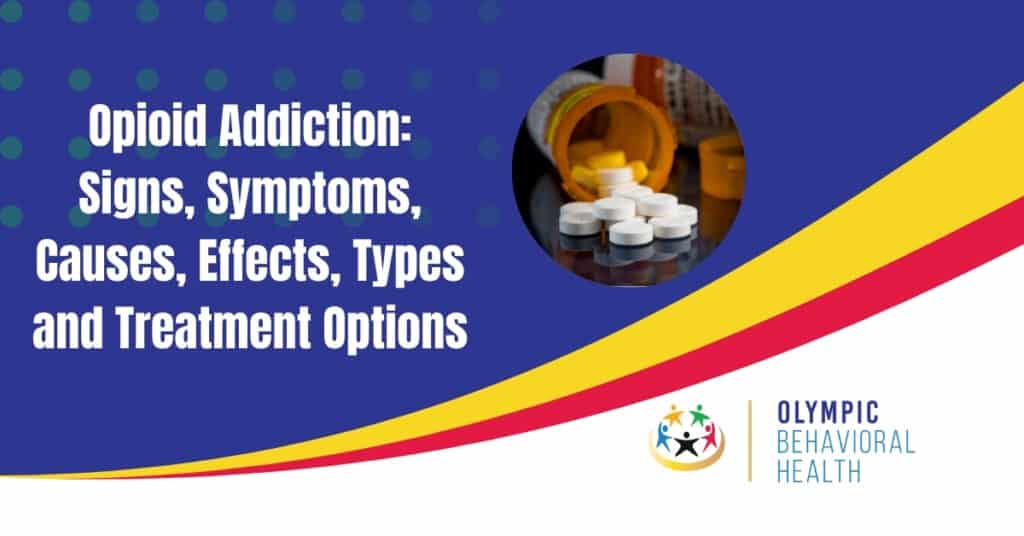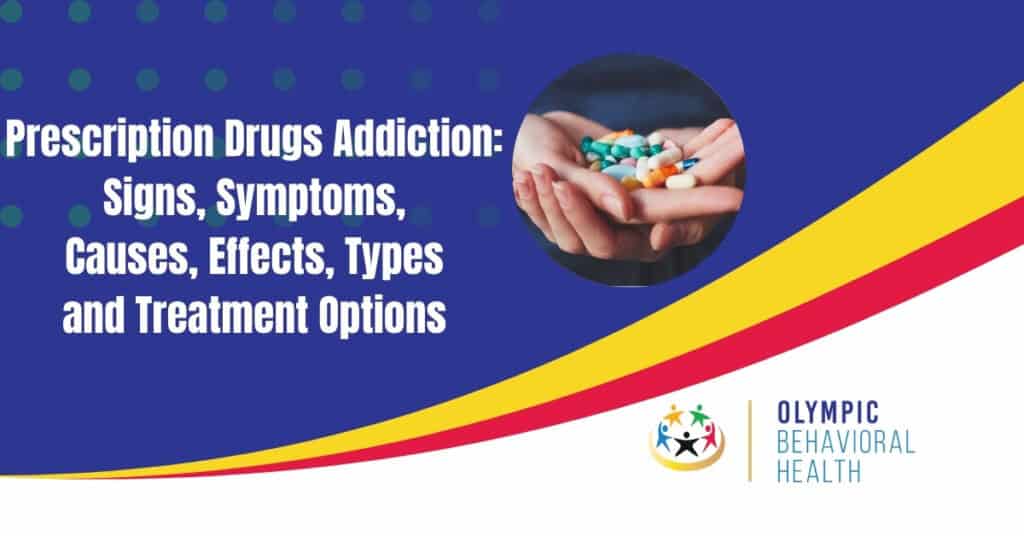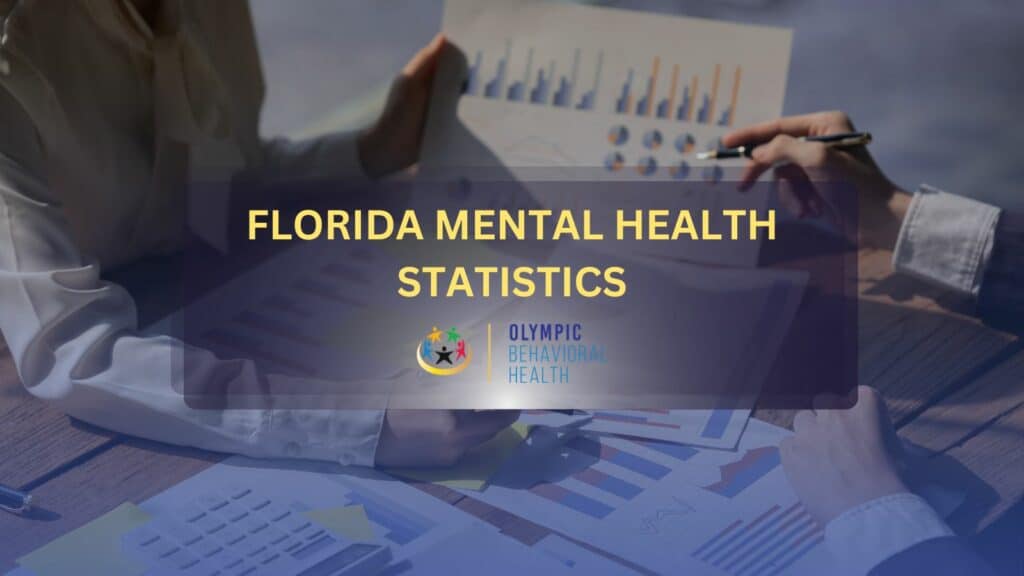Addiction is a complex, chronic condition marked by the compulsive use of substances or engagement in behaviors despite adverse outcomes. It encompasses a spectrum of signs and symptoms that manifest through behavioral, physical, and social changes in individuals. Timely recognition of these indicators is crucial for prompt intervention and successful treatment outcomes.
Behavioral changes are often one of the first indicators of addiction, with individuals exhibiting alterations in their actions and decision-making processes. These changes include increased secrecy, financial difficulties, neglect of responsibilities, and shifts in social circles.
Physical changes associated with addiction are also significant, manifesting in various physiological symptoms that are observed externally. These include fluctuations in weight, changes in energy levels, altered sleep patterns, and unexplained injuries or wounds.
Additionally, addiction profoundly impacts an individual’s social functioning, leading to changes in their interpersonal relationships, social activities, and overall engagement with their community. Withdrawal from social activities, increased isolation, and strained relationships are common social signs of addiction that require attention and support.
What is an Addiction?
Addiction is a persistent, multifaceted condition characterized by the uncontrollable urge to consume substances or engage in activities, even when they result in harmful consequences. Addiction spans various types, including substance addiction (such as drugs or alcohol) and behavioral addiction (like gambling or gaming). According to Hartney, E. et al. 2023, “Signs and symptoms of addiction: How to recognize if addiction may exist,” there are many different signs and symptoms of addiction.
Addiction involves profound changes in the brain’s structure and function, particularly in areas associated with reward, motivation, and decision-making. Chronic substance abuse alters neurotransmitter systems, impairing the brain’s ability to regulate impulses and control behavior. This neuroadaptation reinforces the cycle of addiction, making it challenging to stop using substances or engaging in addictive behaviors.
How Does Someone Develop an Addiction?
Addiction develops through a combination of genetic, environmental, and psychological factors, where genetic predisposition plays a significant role. According to Ducci, F., & Goldman, D. et al. 2012, “The Genetic Basis of Addictive Disorders,” certain individuals are more susceptible to addictive behaviors due to inherited traits ranging between 0.4 (hallucinogens) to 0.7 (cocaine).
Environmental factors, such as exposure to substance use within the family or peer groups, also contribute to the development of addiction.
Additionally, psychological factors like trauma, stress, and mental health disorders also increase vulnerability to addiction. Early initiation of substance use during adolescence further heightens the risk.
Signs That You May Have a Drug Problem
- Continued use of a drug after its medical necessity has ceased.
- Development of tolerance, requiring larger doses to achieve previous effects.
- Experience discomfort or withdrawal symptoms when the drug wears off, including shakiness, depression, nausea, sweating, headaches, fatigue, confusion, seizures, or fever.
- Inability to stop drug use despite negative consequences in personal, social, or professional life.
- Difficulty setting and adhering to self-imposed limits on drug use, often exceeding intended amounts or frequency.
- Loss of interest in previously enjoyed activities.
- Impaired performance in daily tasks like cooking or working.
- Engaging in risky behaviors such as driving under the influence.
- Resorting to borrowing or stealing money to finance drug purchases.
- Strained relationships with coworkers, teachers, friends, or family members.
- Changes in sleeping or eating patterns.
- Physical changes include bloodshot eyes, bad breath, tremors, frequent nosebleeds, weight fluctuations, or an altered appearance.
- Associating with a new peer group involved in drug use.
- Doctor shopping to obtain multiple prescriptions for the same drug.
- Unauthorized use of prescribed medications in combination with alcohol or other drugs.
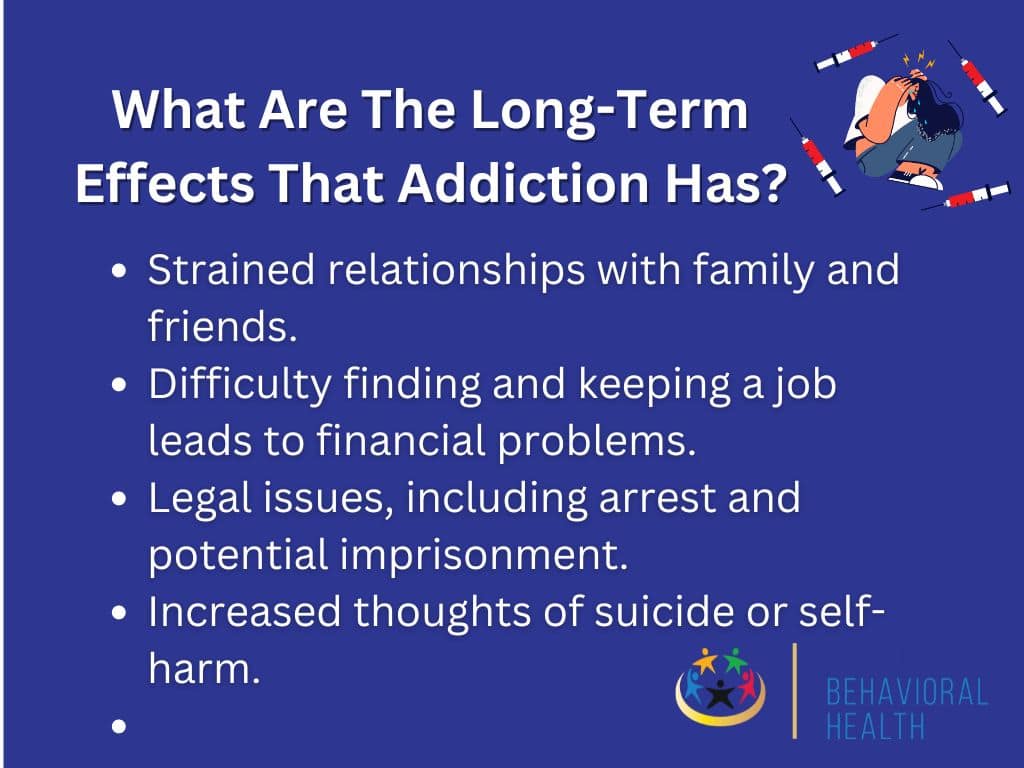
What Are The Long-Term Effects That Addiction Has?
Addiction isn’t just a short-term struggle; it has lasting consequences that affect various aspects of life. If left untreated, addiction can lead to:
- Strained relationships with family and friends.
- Difficulty finding and keeping a job leads to financial problems.
- Legal issues, including arrest and potential imprisonment.
- Increased thoughts of suicide or self-harm.
Additionally, addiction to substances like alcohol and drugs often causes long-term physical health problems, such as:
- Liver damage and problems with liver function.
- High blood pressure leads to strokes and heart problems.
- Changes in brain function and cognitive impairment.
- Conditions like pancreatitis and gout affect overall health.
- Stomach ulcers and gastrointestinal issues.
- Sexual dysfunction and reproductive health problems.
- Kidney problems and an increased risk of kidney failure.
- Weakened immune system, making it easier to get sick.
- Higher risk of various types of cancer.
Signs That Someone Else Is Addicted
Identifying signs of addiction in someone else can be crucial for offering support and intervention. Look out for the following indicators:
- Noticeable shifts in behavior and personality, like decreased motivation, irritability, and agitation.
- Bloodshot eyes, frequent nosebleeds, trembling hands, or slurred speech.
- Significant changes in daily habits or routines include neglecting responsibilities or withdrawing from usual activities.
- A lack of attention to personal hygiene or appearance.
- Unexplained need for money or financial difficulties.
- Noticeable change in social circles or activities.
Signs of an Alcohol Addiction
Behavioral Signs
- Using alcohol in larger amounts or over a longer period than intended.
- Persistent desire or unsuccessful attempts to cut down or control alcohol use.
- Spending excessive time obtaining alcohol, using it, or recovering from its effects.
- Giving up important social, occupational, or recreational activities due to alcohol use.
- Continuing alcohol use despite recurrent social or interpersonal problems caused by it.
Physical Signs
- Craving or experiencing a strong urge to consume alcohol.
- Developing tolerance needs more alcohol to achieve the same effect.
- Experiencing withdrawal symptoms such as insomnia, hand tremors, nausea, or vomiting when drinking stops.
Social Signs
- Failing to fulfill role obligations at work, school, or home due to alcohol use.
- Using alcohol in situations where it is physically hazardous, like during driving.
- Continuing alcohol use despite knowledge of physical or psychological problems caused by it.
Signs of a Cannabis Addiction
Behavioral Signs
- Frequent, unexplained absences and declining performance at work or in school.
- Engaging in lying, secrecy, or deception about whereabouts and activities.
- Possessing paraphernalia such as rolling papers or water pipes.
- Using cannabis in dangerous situations, such as before driving.
Physical Signs
- Bloodshot eyes.
- Dry mouth.
- Increased appetite.
- Fatigue, lethargy, and excessive sleepiness.
- Impaired balance and coordination.
Social Signs
- Withdrawing from family and friends and associating with new peers with similar habits of drug abuse.
- Financial problems due to spending money on drugs or unemployment.
- Loss of interest in hobbies and reduced desire to engage with partners or friends.
Signs of an Opioid Addiction
Physical Signs
- Constricted pupils (small pupils).
- Decreased respiratory rate.
- Non-responsiveness or drowsiness.
- Fluctuations in appetite, resulting in weight loss or gain.
- Intense flu-like symptoms, including nausea, vomiting, sweating, and shaky hands, feet, or head.
Behavioral Signs
- Decline in academic performance or work productivity.
- Engagement in secretive and isolating behaviors.
- Mood swings, irritability, nervousness, or giddiness.
- Tendency to engage in illegal activities or stealing behaviors.
Social Signs
- Withdrawal from social interactions and gatherings.
- Loss of interest in previously enjoyed social activities.
- Breakdown in relationships with family and friends.
Signs of a Benzodiazepine Addiction
Behavioral Signs
- Frequent impairment resembling alcohol intoxication.
- Taking higher doses of medication than prescribed.
- Struggling to fulfill daily responsibilities.
- Isolation and secretive behavior surrounding benzodiazepine use.
- Exhibiting heightened anger or agitation while using or craving benzodiazepines.
- Resorting to stealing or using others’ medication without their knowledge.
Physical Signs
- Persistent drowsiness and sedation.
- Confusion and disorientation.
- Dizziness and lightheadedness.
- Blurred vision, decreased coordination, and slurred speech.
- Impaired judgment and decision-making abilities.
Social Signs
- Withdrawal from social interactions and activities.
- Neglect of relationships with family and friends.
- Financial difficulties due to spending on benzodiazepines.
Signs of a Methamphetamine Addiction
Behavioral Signs
- Increased hyperactivity and restlessness.
- Display of twitching, facial tics, or jerky movements.
- Heightened paranoia and suspicion.
- Agitation and irritability.
- Mood swings or sudden outbursts.
- Erratic sleeping patterns, including insomnia or oversleeping.
Physical Signs
- Dilated pupils, often appearing unusually large.
- Presence of skin sores or lesions.
- Rapid eye movement (nystagmus).
- Reduced appetite, neglect of basic nutritional needs, and rapid weight loss.
- Burns, particularly around the lips or fingers.
- Dental problems, such as rotting teeth and gum disease.
Social Signs
- Withdrawal from social activities and isolation from friends and family.
- Loss of interest in maintaining relationships or fulfilling social obligations.
- Increased involvement in secretive or suspicious behavior.
- Financial problems and erratic spending patterns related to drug acquisition.
- Involvement in criminal activities to support a drug habit.
Signs of a Cocaine Addiction
Behavioral Signs
- Increased tolerance and inability to cut down or control cocaine intake.
- Experiencing agitation and restlessness.
- Neglecting responsibilities and relationships.
- Engaging in reckless and risky behaviors.
Physical Signs
- Elevated body temperature, high blood pressure, and profuse sweating.
- Frequent nosebleeds.
- Loss of appetite.
- Bursts of energy followed by crashes.
- Insomnia or reduced need for sleep.
Social Signs
- Acting impulsively or displaying increased energy levels.
- Attempting to borrow or steal money to fund cocaine habit.
- Being dishonest about whereabouts, associates, and activities to conceal cocaine use.
What Are Common Signs That Are A Teen Is Addicted
Discovering signs of drug abuse in teenagers is vital for timely support and intervention. Teenage drug abuse often reveals itself through changes in behavior, physical appearance, and emotional well-being. Noticeable shifts like withdrawal from usual activities and secretive tendencies signal involvement with substances.
Additionally, physical signs such as bloodshot eyes and irregular weight fluctuations often hint at possible drug misuse. Frequent mood swings and shifts in personality traits, such as increased impulsivity or risky behavior, also indicate underlying substance abuse issues.
Read our blog, Signs of Drug Abuse in Teens, to learn in detail about the common indicators that may suggest a teen is grappling with substance misuse.
What Are Common Signs That Your Partner Is Addicted
Watch for physical changes like bloodshot eyes, weight fluctuations, and injection marks, along with environmental clues such as drug paraphernalia and secretive behavior.
Behavioral shifts like mood swings, financial instability, social distancing, and lack of intimacy also indicate underlying substance abuse. For more detailed insights, refer to our blog on Signs of Drug Abuse in a Partner. By identifying these signs early, you can offer support and encourage your partner to seek help for their addiction.
What Are Common Signs That Your Veteran Parents Are Addicted
The common signs of drug abuse in your veteran parents include changes in behavior, appearance, and daily routines. Be watchful of any secretive actions or the presence of drug paraphernalia. Sudden mood swings, social withdrawal, and financial instability are often common red flags.
Explore our informative blog on Signs of Drug Abuse in Veterans for deeper insights because early recognition of these signs enables effective intervention and access to the necessary treatment and support services for your veteran parents.
Is addiction a disease?
A: Yes, addiction is recognized as a chronic disease by medical professionals and organizations such as the American Society of Addiction Medicine (ASAM) and the Diagnostic and Statistical Manual of Mental Disorders (DSM-5).
What causes addiction?
A: Addiction is influenced by a combination of genetic, environmental, and psychological factors. Genetic predisposition, trauma, stress, and early substance use are among the many factors that contribute to the development of addiction.
How do you overcome an addiction?
A: Overcoming addiction often requires a comprehensive approach involving medical treatment, therapy, support groups, and lifestyle changes. Seeking professional help from healthcare providers and addiction specialists is essential for successful recovery.
What are the complications of addiction?
A: Addiction can lead to various complications, including health problems, legal issues, financial instability, relationship conflicts, and social isolation. These complications can have profound and long-lasting effects on individuals’ lives.
How can I help someone struggling with addiction?
A: Supporting someone with addiction involves offering compassion, understanding, and encouragement. Encouraging them to seek professional help, providing emotional support, and participating in their recovery journey can make a significant difference.

Share This Post
